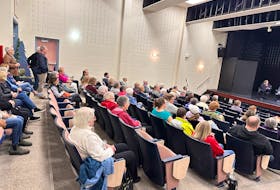There’s a special dancer who gets the crowd on their feet every year at the annual Lebanese levee in Charlottetown.
Behind the jewels and mesmerizing dance moves is Miryam Khoury, a belly dancer from Montreal who performed in front of a sold-out crowd for the fourth year in a row at the 56th Lebanese Levee at the Delta Hotel on Saturday.
“Not only is she very professional but she knows how the art is done,” said Nick Tweel, the event’s emcee. “She knows how to work the crowd.”
Khoury swayed through aisles of tables, connecting with the crowd by inviting people to dance with her.
Belly dancing is one of the staples of the annual Lebanese levee, which is a New Year’s celebration organized by the Canadian Lebanese Association of P.E.I. It also featured drummer Fadi KOD and traditional Lebanese cuisine.
This year’s event had a sold-out crowd of about 650 people.
When Khoury began travelling to P.E.I. for the Lebanese levee she said she didn’t know what to expect at first.
“The first time it was a new experience for me and now I feel more comfortable,” she said. “The people are so warm and so nice every time I come.”
Khoury has spent her entire life dancing.
She performed traditional African dances and folkloric dances since she was a little girl growing up in Peru.
She started belly dancing after moving to Montreal 12 years ago when she tried out a class at the gym.
Belly dancing is an expressive dance which takes skill, she said.
“It’s a hard dance because you have to be very soft with your hands and your head but your hips are very strong,” she said.
Belly dancing originated in Egypt and is a tradition in Lebanese culture as well as in Peru and many other countries.
“I like to see the belly dancer because that’s part of our culture, me as a Syrian, so I’m so interested to see the belly dancer and her costumes,” said Hida Natafji, who lives in Charlottetown and attended the levee.
Khoury also has a connection to the Lebanese culture because her husband is from Lebanon and she has travelled to the country four times.
P.E.I. is not the only place Khoury has belly danced for a crowd.
She has danced in New York City, Taiwan and Spain.
She also dances about once a week with her dance troupe called Bellysemas, which consists of four dancers.
Khoury said belly dancing channels a strong connection to femininity.
“I think that every woman should do belly dancing,” she said. “You really feel like a woman.”
Khoury said she hopes to keep returning for the levee in the coming years.
“I hope that next year I’m going to come, maybe with other belly dancers too,” she said.








